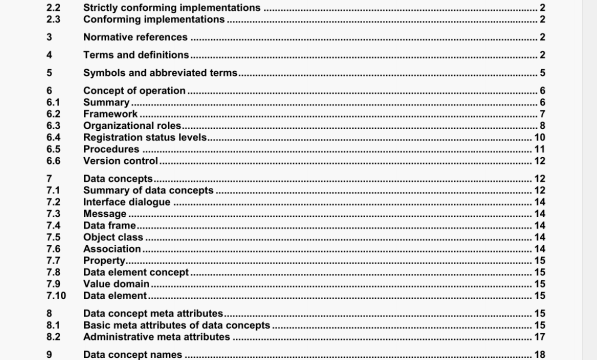ISO 14817 pdf download – ISO 14817 pdf Transport information and control systems -Requirements for an lTS/TICscentral Data Registry and ITS/TICS Data Dictionaries.
7.8 Data element concept
A data element concept shall cons*st of a obØct class and a property. While in a form similar to a data element, a data element concept is devoid of a value domain or representation. In Figure 3, the data element concept example is Bus.identiflcatioW.
7.9 Value domain
A value domam shall be a term that Indicates, precisely and unambiguously, the format arid syntactic form for data concept Instance values. A value domain is one of three data concepts used to characterize a data element. In Figure 3, the value domain example is :identifiem.
7.10 Data element
A data element shall be a formalized representation of some information (i.e.. a pmoperty e.g.. a fact, proposition, or an observation) about an object class (eg. a person, place, process, concept, association. state, or event), with an explicit value domain. A data element (a data concept) shall be characlenzed by three data concepts (see Figure 3): object class, property, and an explicit value domain descriptive name (and value domain reference, where applicable, desaibing the physical form of the information). In Figure 3. the data element example Is ‘Busidentlflcatlon:ldentlfier”. See F5 for an example ASN.1 Information Object Speciftcation of a data element.
8 Data concept meta attributes
8.1 Basic meta attributes of data concepts
8.1.1 Meta attribute categories
The basic mete attribute categories of identification, definitional, relational and representational shall be used In the ITSiTICS Data Registry and ITS/TICS Data Dictionaries. The definition of each meta attribute Is provided in Annex B. See Annex C for rneta attribute applicability to various data concepts
NOTE These basic mete attributes may be represented m one or rie (mets) data models to relIed more completely Sie relationships among 5’.e data While selected mete atb-e,utes are based upon ASN. I Syntax for data representatn, alternative metal data models may result w, alternative syntax. Consequentiy. addwtional mets attributes ID suppon other syntases leg. CORBA IDL. EDIFACT Graphical Syntax. XML Schema) may be added in future revisions and some existing mandatory attributes may become optional.
8.1.2 IdentifIcation mete attributes
Identification attributes shall differentiate one data concept from another. For example, the Data Concept Identifier together with Data Concept Version is a unique Identification ‘tag for a data concept within the ITS1TICS Data Registry. The ASN.1 Object identifier is also a unique identifier for each data concept. Other identification mete attributes may be used, e.g. Descriptive name and Synonymous Descriptive Name, for identification purposes but may be less precise. Sea B.2.
The identification rneta attnbutes shall be as identified below.
Steward Organization name
— Steward phone number
Submitter orgamzation name
— Submitter phone number
User
— View
Related groups
— Security dass
9 Data concept names
9.1 Descriptive names
Descriptive names shall be formulated wtien oeveioping data concepts, cequiremenis tor oeveiop4ng descrçtive names for data concepts, their component parts, end their abbreviations are described in Annex 0. These requirements shall apply to the entire ITS1TICS data envwonment
The descriptive name shall be a name that represents the meaning of a data concept. The descriptive name often serves as a synopsis of the data concepts definition. Abbrewated names are used pnmanly as physical names, and are also referred to as symbolic names, internal names, or access names in appbcation database environments and application program interfaces or messages. When names are formulated by combining multiple terms that povide a more complete characterization of the data concept being named, then separators shall be used in various combinations to enhance readability. Use of these separators: period, colon, left caret, iighl caret, arid dash is defined in Annex D.
The descriptive name shal be unique.
9.2 Data concept descriptive name formats
Descriptive names shall be constructed by combining the relevant component descriptive names with specific separators. The formats are shown Table 3.
ISO 14817 pdf download – ISO 14817 pdf Transport information and control systems -Requirements for an lTS/TICscentral Data Registry and ITS/TICS Data Dictionaries
